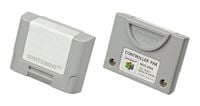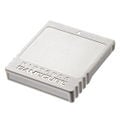Memory Card: Difference between revisions
mNo edit summary |
(A good enough start in my eyes, personally. eBay listings' photos are very, very convenient to get to look at the back of game covers, where GC block info is listed in the upper left.) |
||
| Line 15: | Line 15: | ||
Nintendo of Europe list the rate for GameCube memory cards as 59 blocks → 4 MB,<ref>[https://www.nintendo.com/en-gb/Support/Nintendo-GameCube/Accessories/Memory-Card-59/Memory-Card-59-619188.html Memory Card 59 — Nintendo of Europe]</ref> which'd result in 66~70 KB per block; but other sources contradict this, indicating that Nintendo of Europe mistakenly listed mega''bit'' as mega''byte'', instead resulting in 7~8 KB per block. | Nintendo of Europe list the rate for GameCube memory cards as 59 blocks → 4 MB,<ref>[https://www.nintendo.com/en-gb/Support/Nintendo-GameCube/Accessories/Memory-Card-59/Memory-Card-59-619188.html Memory Card 59 — Nintendo of Europe]</ref> which'd result in 66~70 KB per block; but other sources contradict this, indicating that Nintendo of Europe mistakenly listed mega''bit'' as mega''byte'', instead resulting in 7~8 KB per block. | ||
{|class="wikitable sortable" style="text-align:center" | |||
|- | |||
!Game | |||
!Blocks | |||
!Kilobytes (KB) | |||
|- | |||
|[[Super Mario Sunshine]] | |||
|7 | |||
|56 | |||
|- | |||
|[[WarioWare, Inc.: Mega Party Game$!]] | |||
|4 | |||
|32 | |||
|- | |||
|[[Mario Party 6]] | |||
|5 | |||
|40 | |||
|- | |||
|[[Mario Kart: Double Dash‼]] | |||
|8 | |||
|64 | |||
|- | |||
|style="background-color:#DDD"|''[[Mario Kart: Double Dash‼]] each Time Trial ghost'' | |||
|style="background-color:#DDD"|5 | |||
|style="background-color:#DDD"|40 | |||
|- | |||
|[[Super Mario Strikers]] | |||
|5 | |||
|40 | |||
|- | |||
|[[Paper Mario: The Thousand-Year Door]] | |||
|17 | |||
|136 | |||
|- | |||
|[[Mario Party 7]] | |||
|6 | |||
|48 | |||
|} | |||
{{br}} | {{br}} | ||
===SD cards=== | ===SD cards=== | ||
Starting with the [[Wii]], [[Nintendo]] became less dependent on proprietary memory cards. It has files of internal memory for saving game data (unlike the GameCube). It does however, have a slot for an [[wikipedia:Secure Digital|SD card]] (also used in cameras and other devices). SD cards can store the Wii's channel data and some game data. Pictures taken on a camera saved on an SD card can be displayed on the Wii's Picture Channel. Some games also use the SD card to store non-main game data (like ''Mario Kart 64'' did on the N64). An example of this was the snapshots that can be taken in ''[[Super Smash Bros. Brawl]]''. These snapshots can be saved onto either the Wii itself or the SD card. | Starting with the [[Wii]], [[Nintendo]] became less dependent on proprietary memory cards. It has files of internal memory for saving game data (unlike the GameCube). It does however, have a slot for an [[wikipedia:Secure Digital|SD card]] (also used in cameras and other devices). SD cards can store the Wii's channel data and some game data. Pictures taken on a camera saved on an SD card can be displayed on the Wii's Picture Channel. Some games also use the SD card to store non-main game data (like ''Mario Kart 64'' did on the N64). An example of this was the snapshots that can be taken in ''[[Super Smash Bros. Brawl]]''. These snapshots can be saved onto either the Wii itself or the SD card. | ||
Revision as of 14:30, April 16, 2024
It has been requested that this article be rewritten and expanded to include more information. Reason: Highlight and write about its relation to games of the Super Mario franchise. Some of the information is also a bit too technical.
A Memory Card is a video game accessory that has been a part of many gaming consoles. Essentially it is an external memory database where game data is saved.
Nintendo consoles
Nintendo 64

The Nintendo 64 was the first Nintendo system to have a memory card. However, it's actually called the Controller Pak by many games. It plugged into the controller's accessory slot. The Controller Pak, however, wasn't necessary for many games as the cartridges that the system used allowed for data to be directly saved onto it (much the same as the cartridges for the Game Boy). Many games just used the Controller Pak for storing non-main game data. An example of this was Mario Kart 64, where all race data was saved onto the game, but Ghosts from time trials were saved onto the Controller Pak. Most Controller Paks could only hold up to 123 pages of memory, 128 total, making 5 pages reserved for formatting purposes.[citation needed] Each Controller Pak is 32 KB, making each page 256 bytes. However, there was an unofficial accessory released in 1998 to allow users to transfer saves onto their computer known as the DexDrive, bypassing the need to buy multiple Controller Paks.
Nintendo GameCube

Unlike the Nintendo 64, the Nintendo GameCube was very dependent on the memory card. As with many disc using games, data was either saved on internal memory or on a memory card. The GameCube has no internal memory and had two slots for memory cards. Games played without the memory card inserted act as if it were being played for the first time and data cannot be saved.
There have been three different kinds of GameCube memory cards that were released. The first could store up to fifty-nine blocks; the second could store up to 251; the third could store up to 1,019. These cards were often color-coded to differentiate themselves: 59-block cards were light gray, 251-block cards were black, and 1,019-block cards were white. Despite 1,019 blocks being the highest capacity of any first-party GameCube memory card, the console is capable of supporting ones up to 2,043 blocks in size, a utility alluded to in unused text in various games and in GameCube development tools.[1]
Nintendo of Europe list the rate for GameCube memory cards as 59 blocks → 4 MB,[2] which'd result in 66~70 KB per block; but other sources contradict this, indicating that Nintendo of Europe mistakenly listed megabit as megabyte, instead resulting in 7~8 KB per block.
| Game | Blocks | Kilobytes (KB) |
|---|---|---|
| Super Mario Sunshine | 7 | 56 |
| WarioWare, Inc.: Mega Party Game$! | 4 | 32 |
| Mario Party 6 | 5 | 40 |
| Mario Kart: Double Dash‼ | 8 | 64 |
| Mario Kart: Double Dash‼ each Time Trial ghost | 5 | 40 |
| Super Mario Strikers | 5 | 40 |
| Paper Mario: The Thousand-Year Door | 17 | 136 |
| Mario Party 7 | 6 | 48 |
SD cards
Starting with the Wii, Nintendo became less dependent on proprietary memory cards. It has files of internal memory for saving game data (unlike the GameCube). It does however, have a slot for an SD card (also used in cameras and other devices). SD cards can store the Wii's channel data and some game data. Pictures taken on a camera saved on an SD card can be displayed on the Wii's Picture Channel. Some games also use the SD card to store non-main game data (like Mario Kart 64 did on the N64). An example of this was the snapshots that can be taken in Super Smash Bros. Brawl. These snapshots can be saved onto either the Wii itself or the SD card.
Before Wii System Menu 4.0 was released, Wiis could only use standard SD cards, which could store up to 2 GB of memory. System Menus 4.0 and later gained the ability to use SDHC cards that could store a maximum of 32 GB of memory. However, most games do not support SDHC cards, such as Super Smash Bros. Brawl.
One block on the Wii is 128KB.[3] If the 512MB capacity of the internal memory were split into 256MB for user use and 256MB were for system use and the user gets 2048 blocks ideally.[citation needed]
Nintendo 3DS
The block system remains in use on the Nintendo 3DS, where 1 block is now 16MB.
| Wii | Wii U | Nintendo DSi | Nintendo 3DS | Nintendo Switch | |
|---|---|---|---|---|---|
| SD | |||||
| SDHC | |||||
| SDXC |
1 - Needs to be on Wii System Menu 4.0 or higher. Most older games are incompatible.
2 - The SDXC card has to be formatted to FAT32 with 32k clusters.
3 - MicroSD only